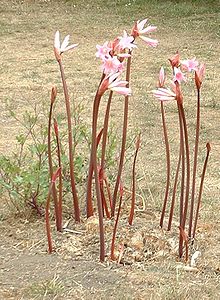Belladonna lily
| Belladonna lily | ||||||||||||
|---|---|---|---|---|---|---|---|---|---|---|---|---|

Belladonna Lily ( Amaryllis belladonna ) |
||||||||||||
| Systematics | ||||||||||||
|
||||||||||||
| Scientific name | ||||||||||||
| Amaryllis belladonna | ||||||||||||
| L. |
The Amaryllis belladonna ( Amaryllis belladonna ), also True Amaryllis called, is a plant from the family of the Amaryllis (Amaryllidaceae). The type of epithet belladonna means 'beautiful woman'. Colloquially and also in the plant trade, other types of the amaryllis family are referred to as "Amaryllis" , in particular the knight star ( Hippeastrum ) species from South America . These are mainly sold as spring onions around Christmas time.
The belladonna lily is a popular and widespread houseplant . It comes from South Africa and was introduced from the southwestern Cape Province in the 18th century.
features
It is a perennial herbaceous plant . This geophyte forms an onion as a persistence organ. The narrow, parallel- veined leaves are about 14 to 60 cm long and die off every year.
The inflorescence shaft is not hollow as in Hippeastrum . Up to twelve flowers stand together on one inflorescence . The hermaphrodite, threefold flowers have a length of 10 cm and a diameter of about 8 cm. The six bracts are identical. The six stamens and the style are curved upwards.
In the Belladonna lily, the strong, bright red flower stems with the light to dark pink trumpet flowers appear in August directly from the leafless bulb. After flowering, the leaves appear , which die off in April / May of the following year. Now the onion goes through its resting phase until August.
The number of chromosomes is 2n = 22, less often 44.
Occurrence
Amaryllis belladonna is native to the southwest and eastern Cape Province of South Africa. However, only in areas with winter rain. The species of the genus Hippeastrum, however, occur mainly in tropical America.
use
Active ingredients
All parts of the plant contain poisonous Amaryllidaceae alkaloids . The highest toxicity content is found in the onion. Amellin is the main alkaloid, further from the alkaloids Lycorin , Caranin , Acetylcaranin and Undulatin before. Depending on the source, lycorine is also given as the main alkaloid. There may be regional and seasonal differences here. The species of the genus Hippeastrum contain similar alkaloids.
use
In the past, extracts of the plant were used as arrow poison . The representatives of both genera are still very popular as ornamental and potted plants.
Symptoms
In humans, symptoms of intoxication include nausea, vomiting, drowsiness, and sweating. Diarrhea and kidney problems also occur. In the case of severe poisoning, death occurs from respiratory failure.
pharmacology
The alkaloids contained in Amaryllis belladonna are toxic to cells and are classified as very toxic (Ib). The seeds and bulbs of Amaryllis and Hippeastrum in particular are very poisonous. Child deaths after eating onions have already been documented in Africa. The LD 50 for mice is 5 mg / kg body weight with intraperitoneal administration. 200 grams of fresh onion material is fatal to sheep. A dose of 2–3 g of onion material is fatal to humans. The LD 50 , only for lycorin, is 41 mg / kg body weight for a domestic dog. Ambellin is analgesic in its effectiveness comparable to morphine . However, the alkaloid is far too toxic for use in medicine. Acetylcaranin has a stimulating effect on the uterus and has antileukemic activity. Caranin, on the other hand, leads to respiratory paralysis and death in animal experiments. The alkaloid lycorin is cytotoxic and also has an emetic and diuretic effect.
First aid and clinical therapy
Induction of vomiting should be carried out as an immediate measure. In addition to the administration of activated charcoal and sodium sulfate, you should drink a lot, especially tea. Shock prophylaxis should also be carried out. In clinical therapy, gastric lavage is performed, if necessary with potassium permanganate. In addition, electrolyte substitution, acidosis treatment with sodium bicarbonate. In addition, kidney function is checked and diazepam is administered in the event of cramps. Intubation with artificial ventilation is indicated for severe poisoning.
swell
- Wink, Michael; Ben-Erik van Wyk; Coralie Wink, Handbook of poisonous and psychoactive plants , Wissenschaftliche Verlagsgesellschaft, Stuttgart, 2008. ISBN 3804724256

